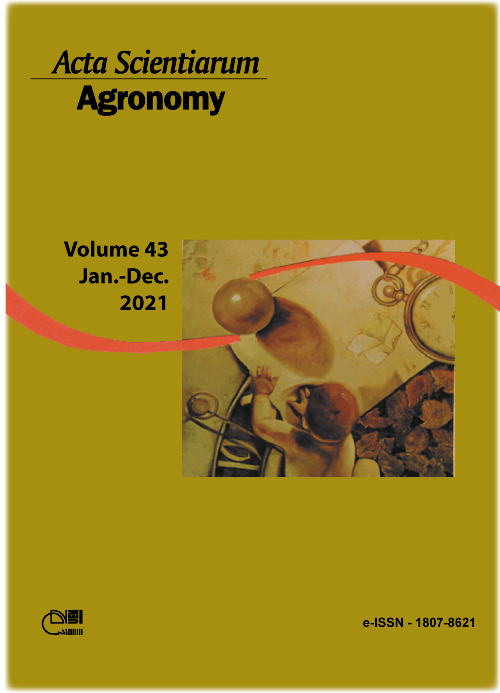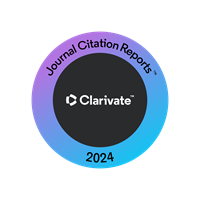Protocol for detecting Curtobacterium flaccumfaciens pv. flaccumfaciens in the leaves of infected bean plants (Phaseolus vulgaris L.)
Abstract
Curtobacterium flaccumfaciens pv. flaccumfaciens (Cff), which is a gram-positive bacterium that causes wilting in several cultivated plants, is one of the main disease-causing bacteria in beans (Phaseolus vulgaris L.). Different techniques are employed to detect pathogens in bean plants; however, only a few slow and inefficient methodologies can be used to detect Cff. Hence, there is a need for rapid and efficient techniques to detect Cff for disease management. The objective of our study was to develop a technique to effectively detect Cff in the leaves of infected bean plants by optimizing a previously developed method. We modified the extraction method by reducing the amount of water used, replacing seeds with leaf tissues (obtained from the veins and petioles) and using CffFOR2 and CffREV4 primers specific for Cff. Our optimized method exploits a concentration gradient generated in the plant tissue through osmosis to disrupt the plant cell wall and efficiently isolate bacterial cells. DNA extracted from the isolated bacterial cells was amplified by polymerase chain reaction. This method allowed efficient detection of Cff in leaf tissues.
Downloads
References
Badel, J. L., Arriel, D. A. A., Guimarães, L. M. S., & Ferraz, H. G. M. (2016). Detecção e identificação de bactérias fitopatogênicas (2a ed.). In A. C. Alfenas, & R. G. Mafia (Org.), Métodos em fitopatologia (p. 423-467). Viçosa, MG: UFV.
Behlau, F., Nunes, L. M., & Leite Junior, R. P. (2006). Meio de cultura semi-seletivo para detecção de Curtobacterium flaccumfaciens pv. flaccumfaciens em solo e sementes de feijoeiro. Summa Phytopathologica, 32(4), 394-396. DOI: 10.1590/S0100-54052006000400017
Deuner, C. C., Souza, R. M., Zacaroni, A. B., Figueira, A. R., & Camera, J. N. (2012). Sensibilidade do método de obtenção das células bacterianas e da técnica de PCR para detecção de Curtobacterium flaccumfaciens pv. flaccumfaciens em sementes de feijão. Summa Phytopatologica, 38(1), 48-53.
Doyle, J. J., & Doyle, J. L. (1987). A rapid DNA isolation procedure for small quantities of fresh leaf tissue. Phytochemical Bulletin, 19(1), 11-15.
Harveson, R. M., Urrea, C. A., & Schwartz, H. F. (2011). Bacterial wilt of dry beans in western Nebraska. Lincoln, US: University of Nebraska; Cooperative Extension; Institute of Agriculture and Natural Resources. Retrieved on Aug. 10, 2019 from http://extensionpublications.unl.edu/assets/pdf/g1562.pdf
Hedges, F. (1926). Bacterial wilt of beans (Bacterium flaccum-faciens Hedges), including comparisons with Bacterium phaseoli. Phytopathology, 16(1), 1-22.
Hedges, F. (1922). A bacterial wilt of the bean caused by Bacterium flaccumfaciens nov. sp. Science, 55, 433-434.
Herbes, D. H., Theodoro, G. F., Maringoni, A. C., dal Piva, C. A., & Abreu, L. D. (2008). Detecção de Curtobacterium flaccumfaciens pv. flaccumfaciens em sementes de feijoeiro produzidas em Santa Catarina. Tropical Plant Pathology, 33(2), 153-156. DOI: 10.1590/S1982-56762008000200010
Junqueira, L. C., & Carneiro, J. (2012). Biologia celular e molecular (9a. ed.). Rio de Janeiro, RJ: Guanabara Koogam.
Leite Júnior, R. P., Meneguim, L., Behlau, F., Rodrigues, S. R., & Bianchini, A. (2001). Ocorrência de Curtobacterium flaccumfaciens pv. flaccumfaciens em feijoeiro no Paraná e Santa Catarina. Fitopatologia Brasileira, 26(Supl.), 303-304.
Mafia, R. G., Alfenas, A. C., & Gonçalves, R. C. (2007). Detecção, isolamento e inoculação de bactérias fitopatogênicas. In A. C. Alfenas, & R. G. Mafia (Org.), Métodos de fitopatologia. (p. 139-160). Viçosa, MG: UFV.
Moreira, M., Noschang, J., Neiva, I. F., Carvalho, Y., & Vicente, V. A. (2010). Methodological variations in the isolation of genomic DNA from Streptococcus bacteria. Brazilian Archives of Biology and Technology, 53(4), 845-849.
Nogueira, C. A. M., Momesso, C. A. S., Machado, R. L. D., Almeida, M. D., & Rossit, A. R. B. (2004). Desempenho de kits comerciais e protocolos laboratoriais para a extração de DNA genômico bacteriano. Revista Panamericana de Infectologia, 6(2), 35-38.
Salton, M. R. J. (1953). Studies of the bacterial cell wall: IV. The composition of the cell walls of some gram-positive and gram-negative bactéria. Biochimica et Biophysica Acta, 10, 512-523. DOI: 10.1016/0006-3002(53)90296-0
Roth, D. A., Saettler, A. W., & Schaad, N. W. (1989). Detection of bacteria in seed and other planting material. St. Paul, MI: APS Press.
Souza, V. L., Maringoni, A. C., & Krause-Sakate, R. (2004). Detecção via PCR de isolados de Curtobacterium flaccumfaciens pv flaccumfaciens. Summa Phytopathologica, 30(1), 89-90.
Tegli, S., Sereni, A., & Surico, G. (2002). PCR‐based assay for the detection of Curtobacterium flaccumfaciens pv. flaccumfaciens in bean seeds. Letters in Applied Microbiology, 35(4), 331-337. DOI: 10.1046/j.1472-765x.2002.01187.x
Trindade, L. C., Marques, E., Lopes, D. B., & Ferreira, M. A. S. V. (2007). Development of a molecular method for detection and identification of Xanthomonas campestris pv. viticola. Summa Phytopathologica, 33(1), 16-23.
Trzewik, A., Nowak, K. J., & Orlikowska, T. (2016). A simple method for extracting DNA from rhododendron plants infected with Phytophthora spp. for use in PCR. Journal of Plant Protection Research, 56(1), 104-109.
Valentini, G., Guidolin, A. F., Baldissera, J. N. C., & Coimbra, J. L. M. (2010). Curtobacterium flaccumfaciens pv. flaccumfaciens: etiologia, detecção e medidas de controle. Biotemas, 23(4), 1-8. DOI: 10.5007/2175-7925.2010v23n4p1
Wendland, A., Alencar, N., Melo, L., Costa, J. G. C., del Peloso, M. J., Pereira, H., & Brondani, R. (2008). Padrão de sintomas de isolados de Curtobacterium flaccumfaciens pv. flaccumfaciens em dois genótipos de feijoeiro comum. Santo Antônio de Goiás, GO: Embrapa Arroz e Feijão. Retrieved on Aug. 10, 2019 from https://www.infoteca.cnptia.embrapa.br/infoteca/handle/doc/216518
Xin, Z., Velten, J. P., Oliver, M. J., & Burke, J. J. (2003). High-throughput DNA extraction method suitable for PCR. Biotechniques, 34(4), 820-826. DOI: 10.2144/03344rr04
DECLARATION OF ORIGINALITY AND COPYRIGHTS
I Declare that current article is original and has not been submitted for publication, in part or in whole, to any other national or international journal.
The copyrights belong exclusively to the authors. Published content is licensed under Creative Commons Attribution 4.0 (CC BY 4.0) guidelines, which allows sharing (copy and distribution of the material in any medium or format) and adaptation (remix, transform, and build upon the material) for any purpose, even commercially, under the terms of attribution.




















































